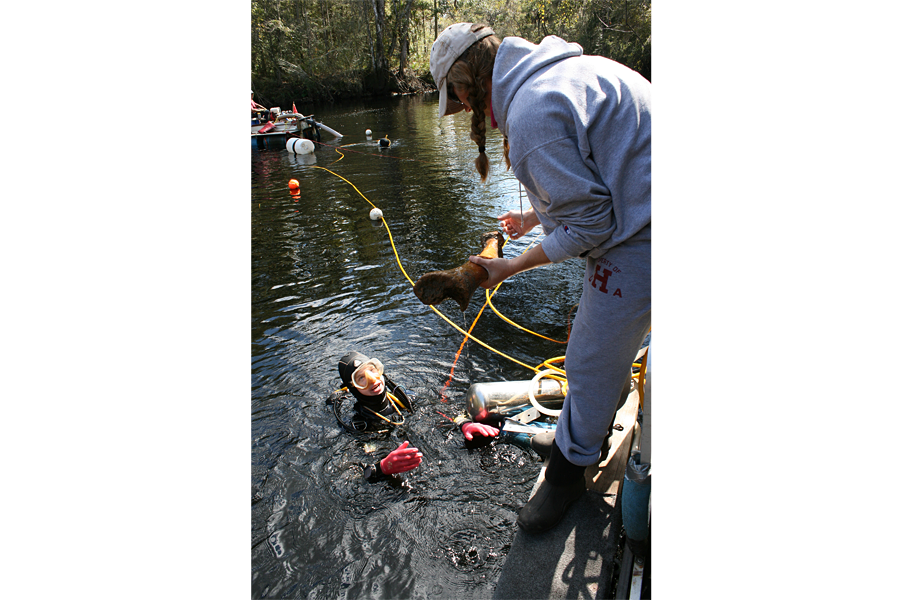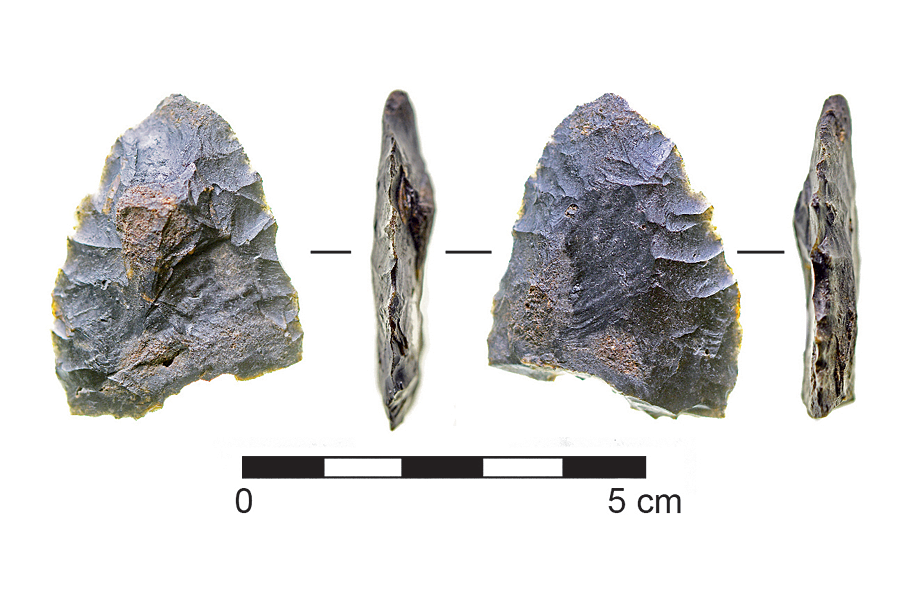Underwater archaeological site recasts 'peopling of the Americas' narrative
Loading...
Deep in an underwater sinkhole in a river in Florida, archaeologists found the remains of a prehistoric population of humans that lived in the region 14,550 years ago. Stone tools, mastodon bones with distinct cut marks, and mastodon dung hold enticing clues into the lives of these early Americans and the megafauna around them. Those new findings are reported in a paper published Friday in the journal Science Advances.
Today these findings are accepted as adding to the early prehistory of the Americas, but that wasn't the case for artifacts unearthed from the same site just decades ago.
This unique archaeological site, which sits 30 feet underwater, was first discovered more than three decades ago when Buddy Page, a former US Navy Seal, spotted it on a dive in the Aucilla River. But when Mr. Page and a team of archaeologists reported that they had found stone tools and a 14,500-year-old mastodon tusk with human-made cut marks on it to the scientific community in the 1980s, they were dismissed.
It was impossible that humans lived anywhere in the Americas before 13,500 years ago, or so archaeologists thought.
At the time, scientists thought they had it all figured out. Here's how the story went:
Humans arrived in present-day Alaska from Siberia via a land bridge that formed thanks to low sea levels during the last ice age. But, because massive ice sheets covered much of North America, they were stuck in a small region of Alaska for thousands of years.
When those ice sheets began to retreat, a corridor opened down the middle of the continent. The people who made their way down that corridor, the Clovis people, were considered the first to spread into the rest of North America, arriving in what is today the United States around 13,500 years ago at the earliest.
"When Clovis-first was king, it was like we had it all figured out," Jon Erlandson, an archaeologist and director of the Museum of Natural and Cultural History at the University of Oregon, who was not part of the dig in Florida, says of that model.
So in the 1980s when the underwater site in Florida, called the Page-Ladson site, was first reported, archaeologists were unwilling to accept that it represented a human presence from more than 14,000 years ago.
At the time, "you were a complete quack if you thought there were pre-Clovis sites in the Americas. You were clearly presenting flawed data in some way, shape, or form," Jessi Halligan, co-principal investigator and first author on the new paper, told reporters in a press teleconference.
"Every potential pre-Clovis site was put through the wringer," Dr. Erlandson tells the Monitor in a phone interview. In fact, it was difficult to get financial support at the time to do research investigating some other explanation for how humans migrated south into the Americas because it was presumed settled. So it's no surprise that the Page-Ladson site was dismissed, particularly because few archaeologists had the training to dive underwater and confirm their findings.
But now the Clovis-first model is "dead in the water," Erlandson says, thanks to a series of pre-Clovis archaeological finds across both North and South America, and genetic data. So "the climate today is much more amenable to people believing it," he says of the Page-Ladson finds.
And Erlandson praises the new research at the old site as "meticulous" and "a triumph for underwater archaeology."
This new paper is "a vindication for those earlier archaeologists," he adds.
"The new work at the Page Ladson site reflects superb archaeological scholarship, that complements and appreciably expands upon the extensive excellent work conducted and reported there previously," David Anderson, associate head of the department of anthropology at the University of Tennessee, Knoxville, tells the Monitor in an e-mail. "The new artifacts, dates, and other lines of evidence provide a compelling case for early human use of the site and, by extension, the region."
Prehistoric Page-Ladson
During their fresh investigation of the site, Dr. Halligan and her colleagues found bifacial stone tools, reexamined the cut marks on the mastodon tusk found during the initial digs, and uncovered mastodon dung.
All of the artifacts were found to be more than 14,000 years old, with one stone knife coming in at 14,550 years old. Although that predates the Clovis people by more than 1,000 years, it's not the only pre-Clovis archaeological site that dates to around that time and the genetic data suggests that people started spreading south into the Americas some 16,000 years ago.
Still, says co-principal investigator Michael Waters, confirming this site "adds another important data point to our story of the first Americans."
And, it expands this early human presence to a fresh region.
"Page Ladson is, without a doubt, the best documented Paleoindian site in the southeast," Dr. Anderson says.
Dung tales
The dung found in the new investigation both helped the researchers date the sediment layers in which artifacts were found and yielded new insights into the mysterious demise of the mastodon.
"When mastodons and other large bodied herbivores were abundant, so was their dung," study co-author Daniel Fisher, director of the Museum of Paleontology at the University of Michigan, said in the press conference. But the dung wasn't the only thing of abundance: a fungus that grew on it was, too.
So the team hunted through the underwater sediment layers for the spores of that fungus as evidence of mastodon presence.
"The concentration of these spores within sediment layers drops dramatically about 2,000 years after the time of the Page-Ladson mastodon, suggesting that this is when the dung of large herbivores finally became too rare for the dung fungus to persist," Dr. Fisher says.
The implication of these findings is that mastodons, and perhaps other megafauna, didn't go extinct until at least 2,000 years after humans arrived on the landscape.
Still, that doesn't confirm if humans hunted the megafauna to extinction as some suggest. Perhaps humans played a role, or perhaps it was climate, as others have suggested.
And the team isn't even sure the mastodon bones found at Page-Ladson come from animals hunted by these prehistoric Americans. "We have many of the bones of the mastodon but we don't have an unambiguous spear point found embedded in the rib area of the mastodon or anything like that," Halligan says.
The reanalysis of the cut marks on the mastodon tusk also appear to come from the process of removing the tusk after the animal died. So, says Dr. Fisher, "hunting versus scavenging is just not something we can distinguish yet for this particular individual."










